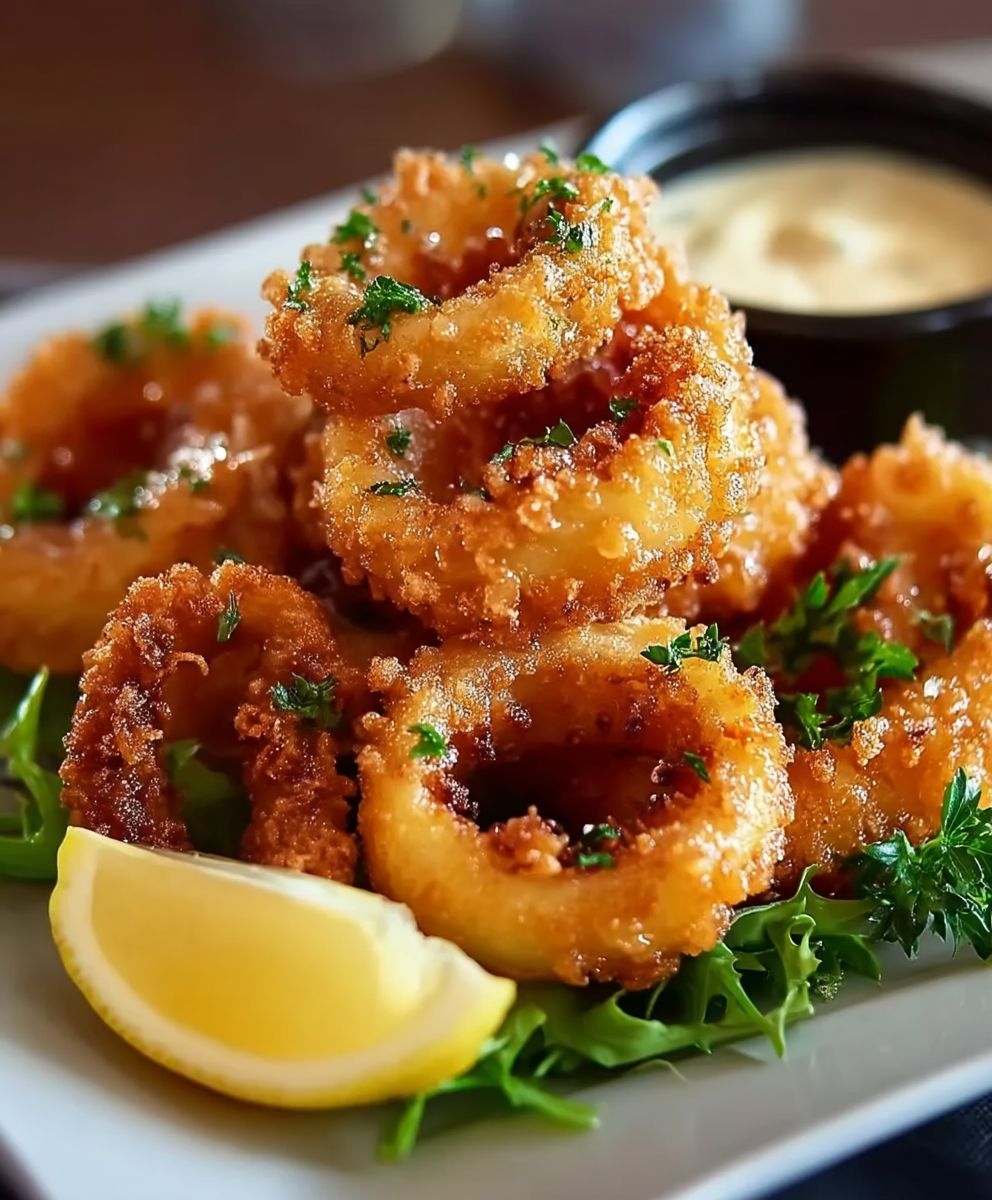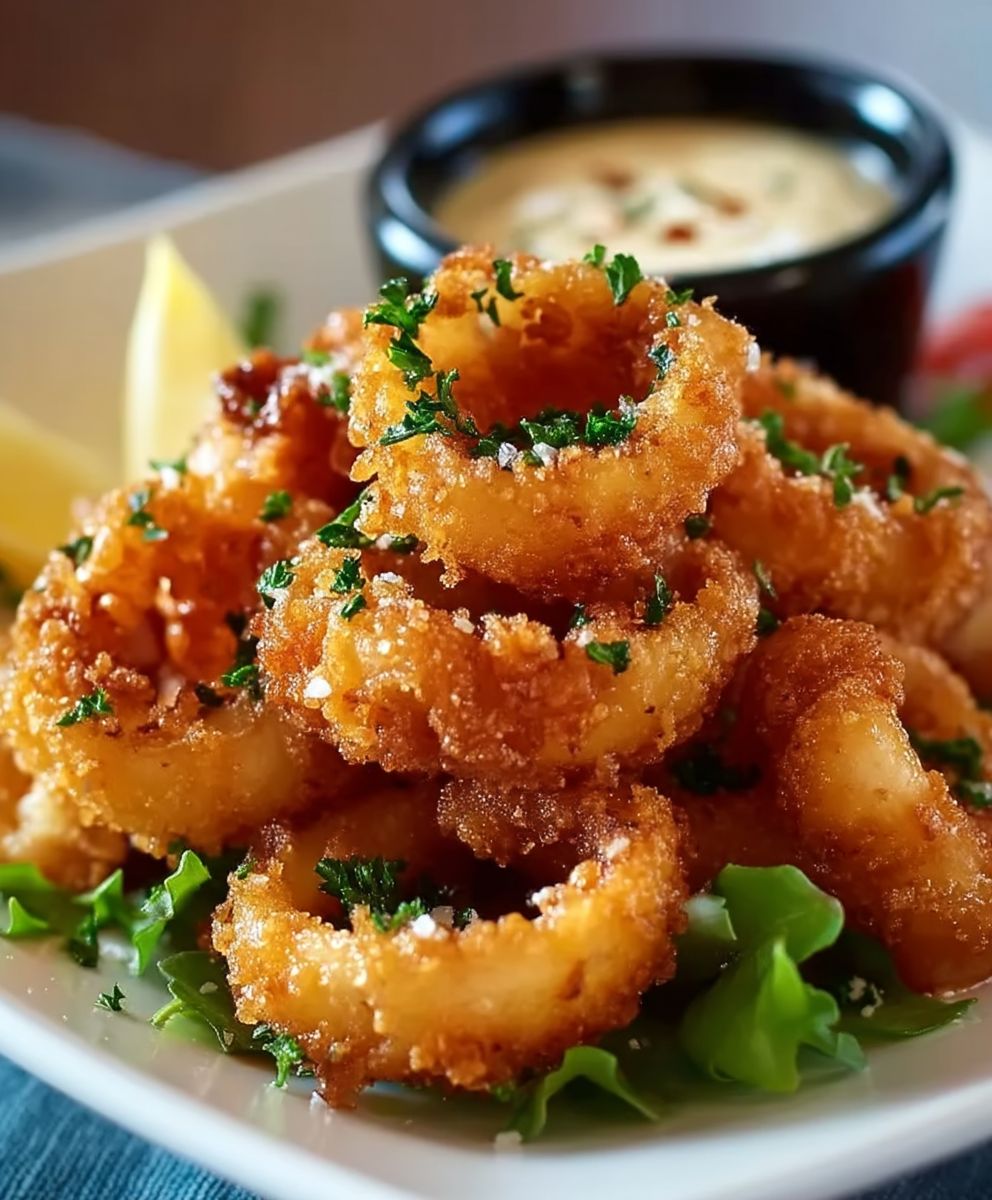Fried Calamari, that crispy, golden-brown delight, is more than just an appetizer; it’s a culinary experience! Have you ever wondered how to achieve that perfect balance of tender squid and shatteringly crisp coating at home? I’m here to guide you through every step, ensuring your homemade Fried Calamari rivals your favorite restaurant version.
The history of calamari stretches back centuries, enjoyed in various forms across the Mediterranean and Asia. While the exact origins of fried calamari are debated, its popularity surged in the United States during the late 20th century, quickly becoming a staple on restaurant menus. Its appeal is undeniable: the delicate, slightly sweet flavor of the squid, contrasted with the satisfying crunch of the fried coating, creates a symphony of textures and tastes that keeps us coming back for more.
People adore fried calamari for its irresistible combination of textures and flavors. The tender, almost melt-in-your-mouth squid, paired with the crispy, seasoned breading, is simply addictive. It’s also incredibly versatile perfect as a starter, a light meal, or even a snack to share with friends. Plus, when made at home, you have complete control over the ingredients and cooking process, ensuring a fresh and delicious result every time. So, let’s dive in and unlock the secrets to perfect fried calamari!
Ingredients:
- 1 pound calamari tubes and tentacles, cleaned
- 1 cup all-purpose flour
- 1/2 cup cornstarch
- 1 teaspoon salt
- 1/2 teaspoon black pepper
- 1/2 teaspoon garlic powder
- 1/4 teaspoon cayenne pepper (optional, for a little kick!)
- 1 cup buttermilk
- 1 tablespoon hot sauce (optional, adds flavor to the buttermilk)
- Vegetable oil, for frying (about 4-6 cups)
- Lemon wedges, for serving
- Your favorite dipping sauce (marinara, aioli, tartar sauce, etc.)
Preparing the Calamari:
- First things first, let’s make sure our calamari is prepped and ready to go. If you bought whole calamari, you’ll need to clean it. Most stores sell it pre-cleaned, which saves a lot of time! If yours isn’t, you’ll need to remove the guts, beak, and quill. Rinse the tubes and tentacles thoroughly under cold water.
- Now, for the tubes, we want to score them lightly in a crosshatch pattern. This helps them cook evenly and prevents them from curling up too much. Just make shallow cuts, don’t go all the way through the tube.
- Next, cut the tubes into rings about 1/2 inch thick. The tentacles can be left as they are.
- Once everything is cut, give the calamari another good rinse and then pat it completely dry with paper towels. This is crucial! Excess moisture will prevent the flour mixture from sticking properly and will result in soggy calamari.
Preparing the Breading:
- In a medium bowl, whisk together the all-purpose flour, cornstarch, salt, pepper, garlic powder, and cayenne pepper (if using). The cornstarch helps create a lighter, crispier coating.
- In another bowl, whisk together the buttermilk and hot sauce (if using). The buttermilk adds a tangy flavor and helps the flour adhere to the calamari. The hot sauce is optional, but I think it adds a nice depth of flavor.
Breading the Calamari:
- This is where things can get a little messy, but it’s totally worth it! Take a handful of calamari and toss it into the buttermilk mixture. Make sure each piece is well coated.
- Next, transfer the buttermilk-soaked calamari to the flour mixture. Toss it around until it’s completely coated in the flour. Press the flour gently onto the calamari to ensure it sticks.
- Place the breaded calamari on a baking sheet lined with parchment paper. This prevents it from sticking and makes cleanup easier.
- Repeat the breading process with the remaining calamari. It’s best to work in batches to avoid overcrowding the bowls.
- Pro Tip: Once all the calamari is breaded, you can refrigerate it for about 30 minutes. This helps the breading adhere even better and results in crispier calamari.
Frying the Calamari:
- Pour the vegetable oil into a large, heavy-bottomed pot or deep fryer. You’ll need enough oil so the calamari can float freely.
- Heat the oil over medium-high heat to 350-375°F (175-190°C). Use a deep-fry thermometer to monitor the temperature. If the oil is too hot, the calamari will burn on the outside before it’s cooked through. If it’s not hot enough, the calamari will be greasy.
- Carefully add the breaded calamari to the hot oil in batches. Don’t overcrowd the pot, as this will lower the oil temperature and result in soggy calamari. Fry for about 2-3 minutes per batch, or until golden brown and crispy.
- Use a slotted spoon or spider to remove the fried calamari from the oil and place it on a wire rack lined with paper towels. This allows the excess oil to drain off, keeping the calamari nice and crispy.
- Repeat the frying process with the remaining calamari, making sure to maintain the oil temperature.
Serving:
- Once all the calamari is fried, season it lightly with salt.
- Serve immediately with lemon wedges and your favorite dipping sauce. Marinara sauce, aioli, tartar sauce, or even a spicy mayo are all great options.
- Enjoy your delicious, crispy fried calamari!
Tips for Perfect Fried Calamari:
- Don’t overcook the calamari! Overcooked calamari will be tough and rubbery. It only needs a few minutes in the hot oil to become tender and crispy.
- Use fresh oil. Old oil will impart a bad flavor to the calamari.
- Maintain the oil temperature. This is crucial for achieving crispy, non-greasy calamari.
- Don’t overcrowd the pot. Fry the calamari in batches to prevent the oil temperature from dropping.
- Serve immediately. Fried calamari is best when it’s fresh and crispy.
Variations:
- Spicy Calamari: Add more cayenne pepper to the flour mixture, or use a spicier hot sauce in the buttermilk.
- Lemon Pepper Calamari: Add lemon pepper seasoning to the flour mixture.
- Garlic Parmesan Calamari: Add grated Parmesan cheese and garlic powder to the flour mixture.
- Herb Calamari: Add dried herbs like oregano, basil, or thyme to the flour mixture.
Dipping Sauce Ideas:
- Marinara Sauce: A classic choice that complements the calamari perfectly.
- Aioli: A garlic mayonnaise that adds a creamy and flavorful touch.
- Tartar Sauce: A tangy and creamy sauce with pickles and herbs.
- Spicy Mayo: A combination of mayonnaise and sriracha or other hot sauce.
- Sweet Chili Sauce: A sweet and spicy sauce that adds an Asian-inspired flavor.
Storing Leftovers:
- Fried calamari is best enjoyed fresh, but if you have leftovers, you can store them in an airtight container in the refrigerator for up to 2 days.
- To reheat, bake the calamari in a preheated oven at 350°F (175°C) for about 5-10 minutes, or until heated through. You can also reheat it in an air fryer for a few minutes. Reheating in a pan is also an option, but be careful not to burn it.
- Keep in mind that reheated calamari won’t be as crispy as it was when it was freshly fried, but it will still be delicious.
Troubleshooting:
- Calamari is Soggy: This is usually caused by not patting the calamari dry enough, not using hot enough oil, or overcrowding the pot.
- Breading Falls Off: This can happen if the calamari isn’t properly coated in the buttermilk and flour mixture. Make sure to press the flour gently onto the calamari to ensure it sticks.
- Calamari is Tough: This is usually caused by overcooking. Calamari only needs a few minutes in the hot oil to become tender.
- Oil is Smoking: This means the oil is too hot. Reduce the heat immediately.

Conclusion:
So there you have it! This recipe for perfectly crispy Fried Calamari is more than just a dish; it’s an experience. From the satisfying crunch to the tender, flavorful squid within, every bite is a testament to the simple yet elegant combination of fresh ingredients and a foolproof cooking method. I truly believe this recipe is a must-try because it delivers restaurant-quality calamari right in your own kitchen, without the hefty price tag or the mystery of what’s *really* going into your food.
But why is it a must-try? Beyond the deliciousness, it’s about the confidence you’ll gain in the kitchen. Frying can seem intimidating, but this recipe breaks down each step, ensuring success even for novice cooks. You’ll learn how to properly prepare the calamari, achieve that perfect golden-brown crust, and avoid the dreaded soggy calamari that plagues so many home cooks. Plus, the entire process is surprisingly quick, making it ideal for a weeknight treat or a weekend appetizer.
Now, let’s talk about serving suggestions! While this Fried Calamari is fantastic on its own, a dipping sauce elevates it to another level. My personal favorite is a classic marinara sauce, its tangy sweetness complementing the savory calamari perfectly. But don’t stop there! A spicy aioli, a creamy garlic dip, or even a simple squeeze of lemon juice are all fantastic options. For a more adventurous twist, try a sweet chili sauce or a vibrant pesto.
And the variations? Oh, the possibilities are endless! Feel free to experiment with different seasonings in the flour mixture. A pinch of cayenne pepper adds a touch of heat, while smoked paprika lends a smoky depth. You could even incorporate dried herbs like oregano or thyme for a more Mediterranean flavor profile. If you’re feeling particularly creative, try adding a bit of grated Parmesan cheese to the flour for an extra layer of savory goodness.
Another variation I love is using different types of seafood. While this recipe focuses on calamari, you can easily adapt it to use shrimp, scallops, or even small pieces of fish. Just be sure to adjust the cooking time accordingly, as different seafoods will cook at different rates.
But the most important thing is to have fun and make it your own! Don’t be afraid to experiment with different flavors and techniques until you find what works best for you. Cooking should be an enjoyable experience, and this Fried Calamari recipe is the perfect opportunity to unleash your inner chef.
I’m so confident that you’ll love this recipe that I urge you to try it out as soon as possible. Gather your ingredients, follow the instructions carefully, and prepare to be amazed by the results. And once you’ve created your own batch of perfectly crispy Fried Calamari, I would absolutely love to hear about your experience! Share your photos, your variations, and your serving suggestions in the comments below. Let’s create a community of calamari lovers and inspire each other with our culinary creations. I can’t wait to see what you come up with! Happy frying!
Fried Calamari: The Crispiest Recipe You'll Ever Need
Crispy, golden-brown fried calamari, perfectly seasoned and served with lemon wedges and your favorite dipping sauce.
Ingredients
- 1 pound calamari tubes and tentacles, cleaned
- 1 cup all-purpose flour
- 1/2 cup cornstarch
- 1 teaspoon salt
- 1/2 teaspoon black pepper
- 1/2 teaspoon garlic powder
- 1/4 teaspoon cayenne pepper (optional, for a little kick!)
- 1 cup buttermilk
- 1 tablespoon hot sauce (optional, adds flavor to the buttermilk)
- Vegetable oil, for frying (about 4-6 cups)
- Lemon wedges, for serving
- Your favorite dipping sauce (marinara, aioli, tartar sauce, etc.)
Instructions
- Prepare the Calamari: If necessary, clean the calamari by removing the guts, beak, and quill. Rinse thoroughly under cold water. Score the tubes lightly in a crosshatch pattern. Cut the tubes into 1/2-inch rings. Leave the tentacles as they are. Rinse again and pat completely dry with paper towels.
- Prepare the Breading: In a medium bowl, whisk together the flour, cornstarch, salt, pepper, garlic powder, and cayenne pepper (if using). In another bowl, whisk together the buttermilk and hot sauce (if using).
- Bread the Calamari: Toss a handful of calamari into the buttermilk mixture, ensuring each piece is well coated. Transfer to the flour mixture and toss until completely coated. Press the flour gently onto the calamari. Place the breaded calamari on a baking sheet lined with parchment paper. Repeat with the remaining calamari. Refrigerate for 30 minutes for crispier results (optional).
- Fry the Calamari: Pour vegetable oil into a large, heavy-bottomed pot or deep fryer. Heat the oil over medium-high heat to 350-375°F (175-190°C). Carefully add the breaded calamari to the hot oil in batches, avoiding overcrowding. Fry for 2-3 minutes per batch, or until golden brown and crispy.
- Serve: Remove the fried calamari with a slotted spoon and place on a wire rack lined with paper towels to drain excess oil. Season lightly with salt. Serve immediately with lemon wedges and your favorite dipping sauce.
Notes
- Don’t overcook the calamari; it only needs a few minutes to become tender and crispy.
- Use fresh oil for the best flavor.
- Maintain the oil temperature for crispy, non-greasy calamari.
- Fry in batches to prevent the oil temperature from dropping.
- Serve immediately for the best taste and texture.
- For Spicy Calamari: Add more cayenne pepper to the flour mixture, or use a spicier hot sauce in the buttermilk.
- Lemon Pepper Calamari: Add lemon pepper seasoning to the flour mixture.
- Garlic Parmesan Calamari: Add grated Parmesan cheese and garlic powder to the flour mixture.
- Herb Calamari: Add dried herbs like oregano, basil, or thyme to the flour mixture.
- Dipping Sauce Ideas: Marinara Sauce, Aioli, Tartar Sauce, Spicy Mayo, Sweet Chili Sauce.
- Storing Leftovers: Fried calamari is best enjoyed fresh, but if you have leftovers, you can store them in an airtight container in the refrigerator for up to 2 days.
- To reheat, bake the calamari in a preheated oven at 350°F (175°C) for about 5-10 minutes, or until heated through. You can also reheat it in an air fryer for a few minutes. Reheating in a pan is also an option, but be careful not to burn it.
- Calamari is Soggy: This is usually caused by not patting the calamari dry enough, not using hot enough oil, or overcrowding the pot.
- Breading Falls Off: This can happen if the calamari isn’t properly coated in the buttermilk and flour mixture. Make sure to press the flour gently onto the calamari to ensure it sticks.
- Calamari is Tough: This is usually caused by overcooking. Calamari only needs a few minutes in the hot oil to become tender.
- Oil is Smoking: This means the oil is too hot. Reduce the heat immediately.

